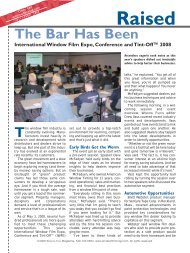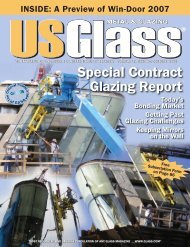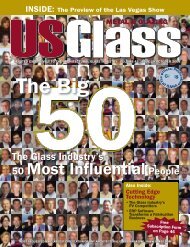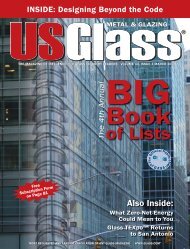US Glass - April 2008 - USGlass Magazine
US Glass - April 2008 - USGlass Magazine
US Glass - April 2008 - USGlass Magazine
You also want an ePaper? Increase the reach of your titles
YUMPU automatically turns print PDFs into web optimized ePapers that Google loves.
theFarnadyFiles<br />
Too Much of a Good Thing<br />
Why Single-Source Shouldn’t Be the Only Option<br />
by Dez Farnady<br />
Once upon a time, a long time<br />
ago—and no, this is not a fairy<br />
tale—I had a customer who<br />
gave me all of his business. We had a<br />
deal where all I needed to do was keep<br />
my price and service competitive and<br />
we both could do well. There were the<br />
occasions when he would ask for a better<br />
price but he often repaid me by<br />
telling me he had some room and<br />
would give me a break by paying more<br />
to keep the deal fair.<br />
Every once in a while, though, the<br />
good thing wasn’t so good. As he came<br />
to rely on me as his sole supplier he lost<br />
his leverage with everyone else—partially<br />
because he was not buying anything<br />
from anyone else and partially<br />
because eventually everyone knew he<br />
was buying it all from me. This is a<br />
small industry. No one was interested<br />
in doing him any favors. He would usually<br />
be forced to look elsewhere when it<br />
was for a product we did not stock or<br />
could not fabricate. When a large job<br />
came by with one of the products I was<br />
not able to provide very effectively we<br />
were both stuck.<br />
Sometimes when he needed something<br />
I could not supply I felt obligated<br />
to try buying-out the product for him.<br />
Rarely was this very profitable. By the<br />
same token, if we ran out of material or<br />
the equipment was down and he<br />
needed product, since he had little in<br />
the way of other options, my problem<br />
became his problem. In spite of all this,<br />
the relationship lasted for many years<br />
but only because it was back in the days<br />
when the product mix was much<br />
smaller. Most commercial jobs were either<br />
cut-size or tempered and either<br />
clear or one of the standard tints. So<br />
how much trouble could we get into?<br />
One Source, No Options<br />
In today’s market with the myriad of<br />
products and options, no one can be all<br />
things to all customers. The singlesource<br />
supplier is barely okay for a small<br />
volume business. If your supplier has a<br />
problem, be it stock or equipment, you<br />
are at his mercy and so is your business.<br />
<strong>Glass</strong> is glass and storefront, for better<br />
or worse, is storefront, and if you can’t<br />
get what you need from one vendor, you<br />
should be able to find another. Not only<br />
is it unpractical, but with giving 90 percent<br />
of your work to one vendor you will<br />
not make friends with the other three<br />
who share your remaining business.<br />
If your supplier has a<br />
problem, be it stock or<br />
equipment, you are at<br />
his mercy and so is<br />
your business.<br />
There may not be an easy answer for<br />
everyone, but supporting multiple suppliers<br />
is a must for all but the smallest<br />
of customers. One good thing is that<br />
now a lot more suppliers have large<br />
product packages and the same or similar<br />
capabilities as competitors. The<br />
other good thing is that they may not<br />
all stock exactly the same materials.<br />
The temperer who also insulates<br />
would rather have you give the IG<br />
to the insulator who also tempers.<br />
The guy with the big cutting capability<br />
would rather you give the<br />
boxed glass to the guy who stocks<br />
case goods while he prefers the<br />
cut-size orders.<br />
For more examples, think of the<br />
supplier who stocks and cuts laminated<br />
as opposed to the other guy who<br />
has an autoclave and lays it up and laminates<br />
for you. The products may be similar<br />
but they are not quite the same. The<br />
price is not likely to be the same either.<br />
And, of course, all low-E products are<br />
alike except when they are not. Some<br />
suppliers carry the PPG product, some<br />
the Cardinal, some the AFG or Guardian<br />
or whoever. And believe it or not, sometimes<br />
you need one and not the other.<br />
Sometimes different fabricators buy the<br />
majority of their bread-and-butter stuff<br />
from one of the float suppliers and not<br />
much from the others so while they may<br />
have a lot of the Versalux colors they may<br />
not have a lot of the Pilkington or PPG<br />
stuff or vice versa.<br />
All fabricators and vendors have their<br />
strengths and their weaknesses. There<br />
are some things they do better than<br />
others. Some things make more money<br />
for them than others and as a result<br />
they will be more competitive in the<br />
areas where they want the business. If<br />
you know this, you can give them what<br />
they want and what they can do well.<br />
This allows you to balance your purchases<br />
among multiple vendors and<br />
keep them all happy. Well, that may not<br />
be true, only all of your business will<br />
make any of them happy. That is until<br />
you need something they can’t do and<br />
then nobody is happy. ■<br />
Dez Farnady serves as<br />
the general manager of<br />
Royalite Manufacturing Inc., a<br />
skylight manufacturer in San<br />
Carlos, Calif. His column<br />
appears monthly. Mr.<br />
Farnady’s opinions are solely his own and<br />
not necessarily those of this magazine.<br />
10 <strong>US</strong><strong>Glass</strong>, Metal & Glazing | <strong>April</strong> <strong>2008</strong> www.usglassmag.com











